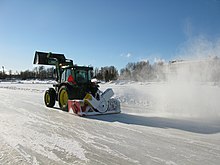Snow blower





A snow blower or snowblower or snow thrower is a machine for removing
Snow blowers range from the very small, capable of removing only a few inches (a few more cm) of light snow in an 18 to 20 in (457 to 508 mm) path, to the very large, mounted onto heavy-duty winter service vehicles and capable of moving 20-foot (6.10 m) wide, or wider, swaths of heavy snow up to 6 feet (1.83 m) deep.
Snow blowers can generally be divided into two classes: single-stage and two-stage. On a single-stage snow blower, the auger (the paddle mechanism visible from the front) pulls snow into the machine and directs it out of a discharge chute. The auger contacts the ground, making single-stage snow blowers unsuitable for use on unpaved surfaces. On a two-stage snow blower, the auger pulls snow into the machine and feeds it into a high-speed impeller, which in turn directs it out of a discharge chute. Two-stage snow blowers can generally handle deeper snow depths than single-stage ones, and because their augers don't touch the ground, they can be used on unpaved surfaces.
Depending on the design, snowblowers can be pressed into service throwing other things, such as water.[1]
History

Robert Carr Harris of
Safety issues
The
Most modern machines mitigate this problem by including a safety system known as the "Dead man's switch" to prevent the mechanism from rotating when the operator is not at the controls; these may be mandatory in some jurisdictions.
Jet-engine snow blowers
Jet engines and other gas turbines are used for large scale propelling and melting of snow over rails and roads. These blowers first were used in Russia and Canada in the 1960s, and were later introduced into the U.S. by the Boston Transportation Authority.
The jet engine both melts and blows the snow, clearing the tracks faster than other methods. While offering considerably greater power in a relatively lightweight machine, this method is much more expensive than traditional snow removing methods. In Russia, the high cost is partially offset by utilizing retired military jet engines, such as the Klimov VK-1.[9][10][11]
See also
References
- ^ "Springtime flooding in Canada: What you need to know". The Globe and Mail. 25 April 2019. Retrieved 25 April 2019.
- ^ Harris, R.C. (September 20, 1870). "US Patent and Trademark Office: US107485". Retrieved 18 February 2014.
- ^ Cole, Robert (April 21, 1923). "US Patent and Trademark Office: US001545235". Retrieved 17 February 2014.
- ^ Mario Theriault, Great Maritime Inventions 1833–1950, Goose Lane Editions, 2001, p. 61
- ^ "The Gilson SNOW BLOWER Shop, Snowblower History". Gilsonsnowblowers.com. 2007-01-27. Retrieved 2014-01-22.
- ^ About Sicard Industries
- ^ "Snow Thrower Safety" (PDF). Consumer Product Safety Commission. Retrieved 2014-01-22.
- ^ a b Steward, Angela (November 16, 2017). "13 Tips for Snow Thrower Safety - Facility Management Grounds Management Quick Read". Facilitiesnet. Retrieved 2018-02-21.
- ^ "5 Absurd Solutions to Huge Problems (That Actually Worked) | Cracked.com". 8 January 2012.
- ^ CSX jet powered snow removal unit
- ^ Relic of a Klimov VK1 engine used to clear Russian runways
